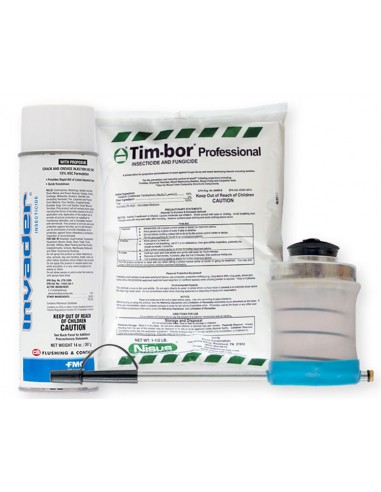Are you worried about termites munching away at your home? You’re not alone.
Termites are the silent destroyers that can cause serious damage before you even realize they’re there. When it comes to battling these tiny invaders, you have options, but which one is right for you? Termite spot treatment and tenting are two popular methods, each with its benefits and drawbacks.
Choosing the right approach can save you time, money, and stress. We’ll break down the differences between termite spot treatment and tenting, helping you make an informed decision that best suits your needs. By the end, you’ll know exactly how to protect your home and peace of mind from these unwelcome guests. Ready to find the best solution? Let’s dive in!

Credit: bluebeetlepest.com
Termite Infestation Signs
Termites are silent destroyers. They often invade homes without immediate signs. Spotting early termite infestation signs is crucial for timely action. Understanding these signs helps choose the right treatment method. Whether it’s spot treatment or tenting, identifying the problem early can save your property from extensive damage.
Physical Damage To Wood
Termites love wood. They eat it from the inside out. Check wooden structures for hollow sounds. Tap the wood lightly; if it sounds hollow, termites may be present. Also look for blistering or dark patches on wood surfaces. These can indicate termites are chewing through the material.
Mud Tubes On Walls
Mud tubes are a clear sign of termite activity. Termites build these tubes to protect themselves while traveling. Look for thin, earthy tubes along walls or foundations. These tubes are usually about the width of a pencil. They can be found in crawl spaces or basements, too.
Discarded Wings Near Entry Points
Swarming termites shed their wings after mating. Finding these wings indoors is a sign of infestation. Check around windows, doors, and other entry points. Wings are typically transparent and resemble fish scales. Their presence often indicates a nearby colony.
Frass Or Termite Droppings
Termites produce droppings known as frass. These resemble tiny pellets. Frass can be found near wooden structures or on the floor. It often looks like sawdust but is darker. Finding frass indicates active termites nearby.

Credit: www.epestcontrol.com
Spot Treatment Explained
When termites invade your home, you face a crucial decision: how to get rid of them effectively without disrupting your life. Spot treatment is a popular choice for targeted termite control. It’s a process that focuses on specific areas of infestation rather than treating the entire house. But how does it work, and what should you expect?
Methods And Techniques
Spot treatment involves applying chemicals directly to the affected areas. Professionals use advanced tools to identify termite hotspots. These tools can range from moisture meters to infrared cameras.
Once identified, the technician injects termiticide into the wood or soil where termites are active. This precision approach means less chemical usage, which can be safer for you and your family.
In a practical sense, imagine finding a small termite colony in your kitchen wall. Instead of treating the entire kitchen, spot treatment targets just that area, leaving the rest of your home untouched.
Benefits And Drawbacks
Spot treatment offers several advantages. It’s less invasive than tenting, meaning you can stay in your home during treatment. It’s also generally quicker, saving time and often money.
However, it has its drawbacks. Spot treatment may not reach hidden colonies deep within the structure. If termites are widespread, it might not be sufficient alone.
Picture this: you’ve opted for spot treatment, but after a few months, you notice signs of termites again. Could it be that some areas were missed? This is a potential risk with spot treatment.
Ultimately, the decision between spot treatment and tenting depends on your specific situation. Are you dealing with a small infestation, or is it more extensive? Consider the trade-offs carefully. Your home is your sanctuary. How much are you willing to disrupt it to ensure termites are gone for good?
Tenting Method Insights
Termite infestations can be a homeowner’s nightmare, and understanding the right treatment method is crucial. The tenting method is a popular choice for tackling these pesky invaders head-on. If you’ve ever wondered what goes into this approach, you’re about to get a detailed look at its process, advantages, and disadvantages. Let’s dive into the tenting method insights and see if it’s the right choice for you.
Process Overview
The tenting method involves covering your entire home with a large tarp or tent. This process creates a sealed environment, allowing fumigants to penetrate every corner of your home. It’s a comprehensive approach that targets termites in areas that are hard to reach.
Professionals will ensure your home is vacated and prepared for treatment. The fumigant is released and left to work for several days. This ensures that termites, no matter where they hide, are eradicated. Once the process is complete, the tent is removed, and your home is aired out.
Pros And Cons
The tenting method offers several advantages. It’s thorough, ensuring termites are eliminated from hidden spots. If you’ve been dealing with stubborn infestations, this could be your best bet for a fresh start.
However, it has its drawbacks. The need to vacate your home for a few days can be inconvenient. Plus, the process can be expensive, especially if your house is large. It also requires careful preparation and post-treatment airing to ensure safety.
Have you considered the logistical aspects? You need to think about where you’ll stay and how you’ll secure your pets and plants. It’s essential to weigh these factors against the method’s effectiveness.
Is the peace of mind worth the cost and effort? Many homeowners find the tenting method a reliable solution despite the temporary inconvenience. Your choice might depend on the severity of the infestation and how much you value a long-term fix.
Comparing Costs
Choosing between termite spot treatment and tenting involves different costs. Spot treatments are generally less expensive. Tenting, while more costly, provides comprehensive protection. Both options offer distinct benefits based on infestation severity and budget.
Termite infestations can wreak havoc on homes. Deciding between spot treatment and tenting involves considering costs. Both methods aim to eradicate termites effectively. Understanding the expenses helps homeowners make informed choices.Spot Treatment Expenses
Spot treatment targets specific areas of infestation. This method often incurs lower costs. Pricing varies based on the size and severity of the infestation. Smaller infestations generally require less treatment. Homeowners might spend hundreds on spot treatments. It’s a cost-effective option for minor issues. Spot treatments don’t always require vacating the home. This saves money on temporary accommodations. The overall expense depends on the infestation’s complexity.Tenting Costs
Tenting involves covering the entire house. This method is usually more expensive. It offers comprehensive eradication of termites. Costs include preparation and fumigation. Homeowners might face thousands in tenting fees. Larger homes incur higher tenting expenses. Temporary relocation adds to the overall cost. It’s suitable for severe or widespread infestations. Despite the higher price, it ensures thorough extermination. Tenting is effective but not budget-friendly for all.Environmental Impact
Termites pose a significant threat to homes, demanding effective treatment solutions. These solutions have varying impacts on the environment. Understanding these impacts is essential for homeowners. It helps in making informed decisions. Termite spot treatment and tenting both have unique environmental footprints. Let’s explore these differences in detail.
Eco-friendly Options
Spot treatment can be more eco-friendly. It targets termites in specific areas. This localized approach reduces chemical use. It minimizes the exposure to non-target areas. Some spot treatments use plant-based products. These are less harmful to the environment.
Tenting involves covering the entire house. It uses more chemicals compared to spot treatment. This can lead to higher environmental risks. However, some companies offer tenting with reduced-impact chemicals. These options are better for the environment.
Chemical Considerations
Spot treatments often use fewer chemicals. This means less impact on surrounding ecosystems. The targeted approach limits chemical spread. This protects beneficial insects and plants nearby.
Tenting requires more potent chemicals. The process involves sealing the home and using fumigants. These chemicals can impact air quality. They can also affect nearby soil and water. Choosing a service with eco-conscious practices can reduce these effects.
Both methods have their pros and cons. Consider the environmental impact before choosing. It ensures a safer choice for your home and planet.
Effectiveness And Longevity
Choosing between termite spot treatment and tenting often depends on effectiveness. Each method has its own strengths. Understanding the longevity of these treatments is crucial. It helps ensure a termite-free home for years. Let’s explore how each option fares in terms of short-term results and long-term solutions.
Short-term Results
Termite spot treatment targets specific areas. It offers immediate relief. This method is effective for isolated infestations. It treats only the affected spots. The process is quick and less disruptive. Homeowners can remain in their homes during treatment.
Tenting, on the other hand, covers the entire structure. It ensures no termite is left behind. The process involves sealing the home. Then, a gas is released inside. This kills all termites in one go. It is suitable for severe infestations.
Long-term Solutions
Spot treatment may need repeated applications. Regular inspections are essential. It does not guarantee complete eradication. This method is more of a maintenance approach.
Tenting offers a more comprehensive solution. It provides long-term protection. The chances of termites returning are lower. Once completed, homeowners enjoy peace of mind. It is often seen as a more permanent solution.
Choosing The Right Method
Choosing between termite spot treatment and tenting depends on the infestation level and property size. Spot treatment targets specific areas, ideal for minor infestations. Tenting treats the entire structure, recommended for severe termite problems.
Choosing the right method for termite control is crucial for homeowners. Each method comes with its own benefits and limitations. Understanding these can help protect your home effectively. Spot treatment and tenting are two common methods. Each suits different situations and needs. Knowing which one fits your circumstances best is key.Factors To Consider
Before choosing a method, consider the extent of the infestation. Spot treatments work well for localized infestations. They target specific areas where termites are active. Tenting treats the entire structure. It is suitable for widespread infestations. Also, assess the type of termites present. Different species require different treatments. Cost is another factor. Spot treatments are often less expensive. Tenting can be more costly. But, it may be more effective for severe cases.Professional Consultation
Consulting a professional can provide clarity. Experts assess the situation accurately. They recommend the most effective solution. Professionals have the experience to identify termite types. They evaluate the severity of the infestation. This helps in choosing the right method. A professional approach ensures safety and efficiency. They also offer preventive advice. This helps in avoiding future infestations. Always seek expert guidance for peace of mind.
Credit: commandpestcontrol.com
Frequently Asked Questions
What Is Termite Spot Treatment?
Termite spot treatment targets specific areas. It uses chemicals to kill termites. Quick and localized.
How Does Tenting For Termites Work?
Tenting covers the whole house. Fumigants are used to kill termites. It treats the entire structure.
Which Is Cheaper: Spot Treatment Or Tenting?
Spot treatment is usually cheaper. It targets small areas. Tenting costs more due to full coverage.
Is Tenting More Effective Than Spot Treatment?
Tenting is often more effective. It kills all termites in the house. Spot treatment may miss some.
Can I Stay Home During Termite Treatment?
Not during tenting. Fumigation requires you to leave. Spot treatment may allow you to stay.
Conclusion
Choosing between termite spot treatment and tenting depends on several factors. Spot treatment targets specific areas, which suits minor infestations. Tenting treats the whole house, effective for severe cases. Consider infestation size and budget. Spot treatment is quicker and less disruptive.
Tenting ensures thorough extermination but requires more time. Consult professionals to decide the best method for your situation. Protect your home from future termite damage. Both methods offer benefits. Choose wisely based on needs. Keep your home safe and secure.



